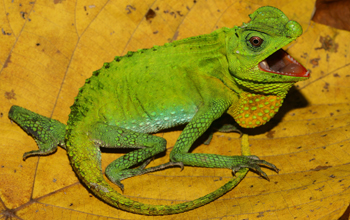Multimedia Gallery
Hump-nosed lizard, Sri Lanka
A hump-nosed lizard (Lyriocephalus scutatus) near Kandy, Sri Lanka.
Alex Pyron, an assistant professor of biology at The George Washington (GW) University, and a team of researchers have created the first large-scale evolutionary family tree--or phylogeny-- for every snake and lizard species on Earth. The team catalogued 4,161 species of snakes and lizards, or squamates.
"Squamates include all lizards and snakes found throughout the globe, including around 9,500 species on every continent except Antarctica, and found in most oceans," said Pyron. "This is everything from cobras to garter snakes to tiny geckos to the Komodo dragon to the Gila monster. They range from tiny threadsnakes that can curl up on a dime to 10 feet monitor lizards and 30 foot pythons. They eat everything from ants to wildebeest."
The phylogeny includes all families and subfamilies and most genus and species groups. Pyron says that, while there are gaps on some branches of the tree, the structure of the tree goes a long way toward fully mapping every genus and species group.
The project was funded by the National Science Foundation Postdoctoral Research Fellowship in Biological Informatics program under grant DBI 09-05765. To learn more about the new phylogeny, see the GW news story George Washington University biologist maps the family tree of all known snake and lizard groups. (Date of Image: June 2011)
Credit: Alex Pyron, George Washington University
See other images like this on your iPhone or iPad download NSF Science Zone on the Apple App Store.
Images and other media in the National Science Foundation Multimedia Gallery are available for use in print and electronic material by NSF employees, members of the media, university staff, teachers and the general public. All media in the gallery are intended for personal, educational and nonprofit/non-commercial use only.
Images credited to the National Science Foundation, a federal agency, are in the public domain. The images were created by employees of the United States Government as part of their official duties or prepared by contractors as "works for hire" for NSF. You may freely use NSF-credited images and, at your discretion, credit NSF with a "Courtesy: National Science Foundation" notation.
Additional information about general usage can be found in Conditions.
Also Available:
Download the high-resolution JPG version of the image. (4.1 MB)
Use your mouse to right-click (Mac users may need to Ctrl-click) the link above and choose the option that will save the file or target to your computer.

